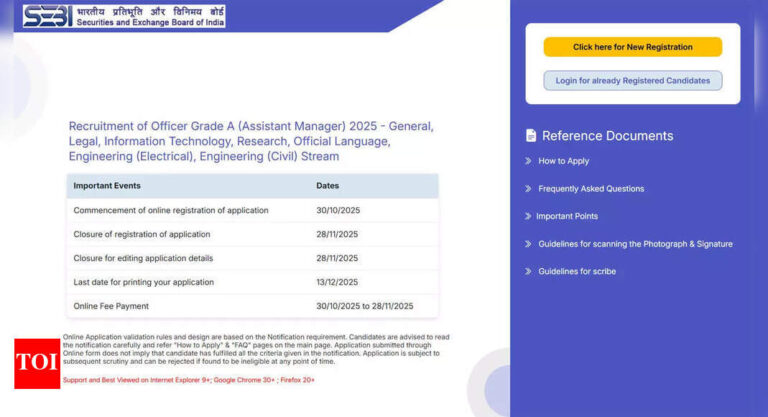
The United States has ended the automatic extension of work permits for certain migrant categories, introducing a rule that will tighten vetting and screening before employment authorisations are renewed. The move, announced by the Donald Trump administration, reverses a policy from the Biden era that had allowed eligible immigrants to continue working legally while their renewal applications were pending.Under the new directive, applicants will no longer receive an automatic extension of their Employment Authorisation Document (EAD) if they file for renewal on or after 30 October, 2025. The United States Citizenship and Immigration Services (USCIS) said the decision was taken to ensure “appropriate vetting and screening” before extending any work-related documentation.USCIS Director Joseph Edlow described the change as a “common sense measure” that reinforces the idea that employment in the United States is a privilege, not a right. The Department of Homeland Security (DHS) said the reform aims to prevent fraud and enable more frequent background checks on those seeking to work in the country.
What is EAD?
The EAD is a work permit issued by US Citizenship and Immigration Services (USCIS). It allows certain non-citizens—such as international students on OPT, some dependent spouses, asylum applicants, and others—to work legally in the United States. The EAD is a physical card that lists the holder’s name, immigration category, and the specific dates they are allowed to work. Without a valid EAD, off-campus employment is generally not permitted.
When do F-1 students need an EAD?
F-1 is a study visa, not a work visa. By default, an F-1 student is in the US only to study, and therefore does not automatically have permission to work. This is why the Employment Authorisation Document becomes crucial. The most common scenario is Optional Practical Training (OPT). OPT allows students to work in jobs directly related to their degree, either during their course (pre-completion OPT) or after they graduate (post-completion OPT). To begin OPT, a student must apply to USCIS and receive the EAD card, which specifies the exact dates during which they are legally allowed to work.Students in STEM fields can later extend this work period by 24 months, but this extension also requires applying for a new EAD.Other situations requiring an EAD include severe economic hardship and employment with certain international organisations.However, on-campus work and CPT (Curricular Practical Training) do not require an EAD. In short: any time an F-1 student works off-campus, they likely need an EAD.
How will the new rule affect F-1 students?
The impact will be felt during EAD renewals for all those who require it including students on the STEM OPT extension. Earlier, when a student applied to extend their OPT work authorisation, they were allowed to keep working while their renewal application was still being processed, as long as they filed before their current EAD expired. This automatic extension acted as a safety buffer, since USCIS processing often takes several months.With the new directive, this automatic extension will no longer apply. This means that if a student’s EAD expires before the renewal is approved, they must stop working immediately—even if they have a job, even if the renewal is in progress, and even if the delay is from the government’s side. Employers will also be required to update work eligibility records, which may put pressure on companies to reconsider hiring students whose authorisation is close to expiry.In practical terms, STEM OPT students will need to apply for renewal much earlier and closely track processing times. Any delay—whether due to paperwork errors, backlogs, or security checks—could result in a forced employment gap, risking income loss, visa status complications, and disrupted career continuity. The change makes the transition from study to work more time-sensitive and uncertain for international students.
Can F1 visa holders apply early to avoid a job gap?
The answer is: No. In the current scenario, USCIS is advising many non-citizens who need EAD renewals (e.g., H-4 spouses, adjustment-of-status and certain asylum applicants) to file up to 180 days before expiry to ensure continuity of work authorisation. However, F-1 OPT/STEM students cannot. Their filing window remains legally capped at 90 days before expiry.
What students should do now
Because F-1 students cannot file EAD renewals 180 days early (unlike many other non-citizens), the timing risk is now much higher. This makes planning and precision essential.
- Check your EAD expiry date today. Count back 90 days — that is the first day you can legally apply for your new EAD.
- Coordinate with your DSO in advance. Your DSO’s STEM OPT recommendation must be no more than 60 days old when USCIS receives your application.
Ask your DSO to prepare the updated I-20 early, so you can file on Day 1 of your window. - File Form I-765 on the earliest eligible day. Any delay — even a few days — can increase the risk of the new EAD not arriving in time.
- Strongly consider Premium Processing. Filing Form I-907 (premium) means USCIS must act within roughly 30 business days, reducing the chance of a work gap.
- Keep your employment reporting airtight. Ensure your I-983, SEVIS updates, and employer reporting are error-free. Even small paperwork issues can slow approval.
- Prepare your employer. Explain the new rule and your non-flexible filing window early, so they understand timing risks and do not panic at expiry checks.
The larger picture
The Trump administration’s focus on vetting is part of a broad push towards stricter immigration controls and increased emphasis on security of the nation. However, it adds a new logistical and psychological burden for students including Indian graduates who are one of the largest cohorts of international students in the US. The risk of work interruptions could deter employers from hiring OPT candidates, who are already navigating complex timelines for H-1B sponsorship.While the DHS describes the rule as a procedural safeguard, its practical impact may be significant. For young professionals seeking to bridge the gap between study and skilled employment, the new policy makes that transition less predictable.








